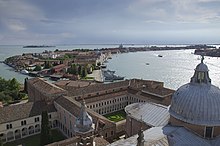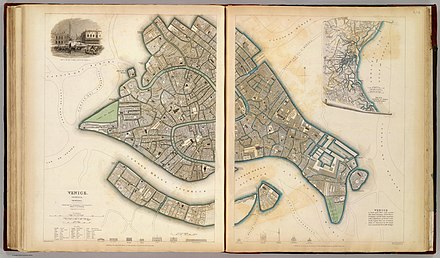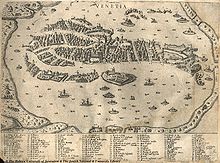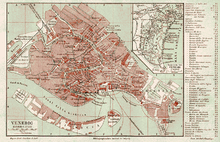Giudecca

The Giudecca is a small elongated archipelago in the south of the city of Venice in Italy , with an area of 58.9 hectares (exactly 589,056 square meters) and a population of 6,429 as of the 2001 census. It is an important part of the sixth of Dorsoduro .
Geographical classification, the canal
The Giudecca is located south of Venice and grew out of originally six, later three, parts together. The archipelago is separated from the lagoon city by the channel of the same name (Canale della Giudecca) . Their even distance is about 300 meters. The journey from St. Mark's Square with a public diesel motor ship ( vaporetto ) takes little more than three minutes. As the largest and closest island in the lagoon, the Giudecca measures no more than 2,000 meters in a west-east direction. From north to south it is no wider than 300 meters. It consists of a total of eight individual islands, which are separated from each other by about five to 40 meters wide canals, five of which cut through the Giudecca from north to south and two others run a short distance in an east-west direction.
The Giudecca is divided into three Roman Catholic parishes, the Dean's Office Vicariato di S.Polo-S. Croce-Dorsoduro in the Patriarchate of Venice include:
- SS Redentore (with SS Trinità - Clarisse and Zitelle) (east, with the quarters Campo di Marte and Quartiere San Giacomo )
- Santa Eufemia (west)
- San Gerardo Sagredo (on the offshore islands of Sacca Fisola and Sacca San Biagio to the west )
The Giudecca belongs to the Dorsoduro district (yellow)
The two eastern sub-islands correspond to the quarters Campo di Marte and Quartiere San Giacomo .
History, origin of the name of the island
It is believed that the island was also called "Vigano" in the early Middle Ages. At this time or later, the name "Spinalonga" (the solidified form of Spina lunga , i.e. long fishbone ) became common because the shape of the island from a bird's eye view is reminiscent of the flexible backbone of a fish.
There are two seemingly divergent main theses about the origin of the name "Giudecca", which is still valid today. According to one reading of its name, the island was named after the Jews ( giudei ), since they were allowed to settle on the island in front of the city instead of Venice. According to this, Giudecca would (as a derivative of giudeo , the middle Italian term for Jew - in contrast to today's Italian ebreo ) specifically designate an "island for Jews". It is also known that the Venetian patrician Giorgio Emo proposed to the Senate of the city-state in 1515 that the city's Jews be permanently and exclusively on the Giudecca. But they got away from that, probably because soldiers' quarters on the island could have provoked unwanted unrest.
A year later, the Senate accepted Zaccaria Dolfin's proposal that the Jews present in Venice should settle in the ghetto , an island on the outskirts of the city that was closed at night. This Venetian inner-city Jewish quarter (in ancient times also gheto ) is possibly the very first ghetto in Italy.
The other explanation for the origin of the island name Giudecca is linked to those convicted of minor offenses (ital. "Giudicati"). Since convicts were brought to the island separated from the city in the early Middle Ages, in this case the idea of the "island of exile" alone could have been the inspiration.
Michelangelo rented a house on the Giudecca for three years between 1529 and 1532 in a kind of voluntary exile .
On old maps and engravings of Venice, numerous aristocratic palaces with huge gardens are marked on the Giudecca (also known as “Giudeca” or, in the old Venetian dialect, “Zueca”).
At the turn of the 20th century, the island with 3000 inhabitants was mainly inhabited by fishermen . In the early 20th century, the Giudecca became an industrial area (especially in its western parts) with shipyards and factories. With the end of the Second World War, a large part of the industrial settlement on the island lost its former importance. Today the Giudecca is being discovered more and more as a residential area, where it is appreciated that you can relax from the tourist hustle and bustle of Venice.
One of the most important buildings on the Giudecca is the Church of Il Redentore , probably the most beautiful and imposing building by Palladio , built in 1576 as a votive church by order of the Senate on the occasion of the end of the plague; the church of Sant'Eufemia (founded in the 9th century), one of the oldest churches in Venice, and the Chiesa delle Zitelle . The church of San Giorgio Maggiore is located off the eastern tip of Giudecca and no longer belongs to it.
At the western end of the island is the Stucky mill , a huge brick building built in the neo-Gothic style, which the pasta manufacturer Giovanni Stucky had built at the end of the 19th century . The Hanoverian architect Ernst Wullekopf was commissioned to carry out various extensions and gave the mill its present form. The Molino Stucky was the largest noodle factory in Italy until the beginning of World War II . After years of vacancy and decay, at the end of the 20th century the mill began to be converted partly into a hotel and partly for cultural and exhibition purposes. This work was interrupted in 2003 by a major fire. In the meantime, the building has been taken over by the Hilton Group and reopened as a hotel.
There was also a film studio on the Giudecca.
Shipping
The number of cruise ships passing through the Canale della Giudecca increased from year to year and in 2012 amounted to 1,700 ships. The sight of them is perceived as a visual impairment. There are also fears of environmental damage and the destruction of the city's foundations by the waves caused by the ships. In November 2013, the Italian government decided to severely restrict shipping traffic on the canal. Large cruise ships over 96,000 GRT have been completely banned since November 2014, and the passage of medium-sized ships over 40,000 GRT is to be restricted by a fifth. Since January 2014, ferries are no longer allowed to travel through the canal.
The Giudecca in German-language literature
| 1786 |
Johann Wolfgang von Goethe
(1749–1832) |
Italian trip |
Venice, September 29, 1786 | |
| 1789 |
Friedrich Schiller (1759–1805) |
The ghost seer .
From the memoirs of Count von O **. fragment |
1st book: 4 5th book, 5th letter, 1st Julius, a) 5th book, 5th letter, 1st Julius, b) |
|
| 1819-1822 |
ETA Hoffmann (1776-1822) |
Serapions brothers |
Doge and Dogaresse, 344 | |
| 1847 |
Fanny Lewald
(1811-1889) |
Italian picture book |
Venice (daylight), 802 | |
| 1855 |
Jacob Burckhardt (1818-1897) |
The Cicerone
Guide to enjoying the works of art of Italy
|
107b: Architecture from 1540 to 1580 (Church del Redentore , 1576) and nunnery delle Zitelle , 1586 108b | |
| 1860-1863 |
Herman Grimm (1828-1901) |
Michelangelo's life
(1860–63)
|
Chapter X, 2 | |
| 1862 |
Paul Heyse
(1830-1914) |
Andrea Delfin . A Venetian novella
|
12 | |
| 1874 |
Theodor Fontane
(1819–1898) |
From the diaries of the trip to Italy, Oct./Nov. 1874
|
1 | |
| 1887 |
Conrad Ferdinand Meyer
(1825–1898) |
The temptation of Pescara |
Chapter 4: 3 | |
| 1889 |
Hugo von Hofmannsthal
(1874–1929) |
The adventurer and the singer |
Chapter 2: 2 |
Mention in non-German-language fiction
| 1790 |
Giacomo Casanova
(1725–1798) |
Volume 2: Chapter 32) |
literature
- Stefania Pizzeghello: Una Venezia da scoprire: l'isola della Giudecca e le sue Associazioni Culturali . tesi di laurea, Università Ca 'Foscari, Venice 2016 ( online ).
Web links
- Incubator for Innovative Enterprise on the island of Giudecca in Venice. (PDF; 3.7 MB)
- Giudecca: virtual tour
- Map with parish boundaries
Coordinates: 45 ° 25 ′ 30 ″ N , 12 ° 19 ′ 20 ″ E
Individual evidence
- ↑ Venice islands: All the islands of Venice by area ( Memento of March 24, 2009 in the Internet Archive )
- ↑ [1]
- ↑ [2] ( MS Word ; 50 kB)
- ^ Otto Julius Bierbaum: Dumont Visuell. Venice , Cologne: DuMont Buchverlag 2000, 5th updated edition ISBN 3-7701-3200-9 , p. 336.
- ↑ Bierbaum, p. 141
- ^ Riccardo Calimani: The merchants of Venice. The history of the Jews in the Lion Republic . Munich 1990, pp. 11-15; Bierbaum, p. 140.
- ↑ Herman Grimm: The Life of Michelangelo. Complete edition. With 24 picture panels. Introduced and with comments by Dr. Karl Augst Laux, Leipzig: Dieterich'sche Verlagsbuchhandlung 1940, p. 533 (Chapter X, 2). In the Gutenberg project, Grimm's biography, The Life of Michelangelo (1860-63) can already be found in digitized form (even if the electronic information does not match that of the original: Chapter X, 2 is correct) : Life of Michelangelo, Chapter X, 2
- ↑ Get out of the Serenissima! Süddeutsche.de, November 6, 2013, accessed on January 1, 2014.














